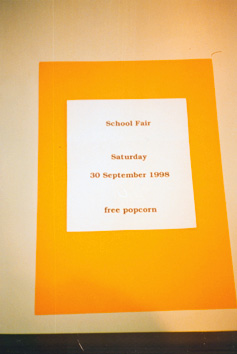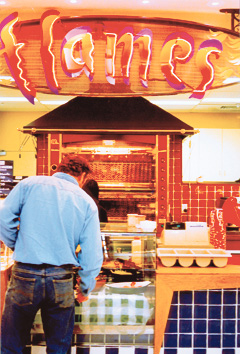 Approach: One
to one Approach: One
to one |
 |
1.3Mb |
Resources: Photographs
of seven signs or posters. |
|
Questions / instructions:
There are lots of interesting signs
and posters that you can see in all sorts of places. Some examples are shown in
these 7 photographs.
|
 |
 |
 |
 |
 |
 |
 |
In
order of appearance from 1 to 7.( press on image for enlarged version
) |
|
|
|
%
responses |
|
y4
|
y8
|
|
Arrange all 7 pictures in front
of student.
1. First, I want you to choose one sign or poster from these pictures that you
think is very good because of the way it has been made.
Allow time. Write picture number on recording sheet.
|
Picture
chosen: 1
2
3
4
5
6
7
|
43
7
1
9
6
3
31
|
32
10
0
17
6
3
32
|
|
2. Now look carefully at the picture
you have chosen. I want you to try to explain to me everything about the way this
sign/poster has been made that makes it very good.
Allow time.
|
Possible
elements include attractive
features, colour, symbolism.
|
|
|
|
clear
with multiple ideas
|
37
|
58
|
|
relevent,
not fully developed
|
29
|
30
|
|
on
right track, but vague
|
26
|
10
|
|
very
limited
|
8
|
2
|
|
3. Now choose one sign or poster
that you think is not very good because of the way it has been made.
Allow time.
|
Picture
chosen: 1
2
3
4
5
6
7
|
1
8
63
6
9
10
3
|
0
5
86
1
4
3
1
|
|
4. Now look carefully at the picture
you have chosen as being not very good. Try to explain to me why it is not very
good — because of the way it has been made.
Student responds.
|
Quality
of explanation: clear with multiple ideas
|
29
|
54
|
|
relevent,
not fully developed
|
34
|
35
|
|
on
right track but vague
|
24
|
9
|
|
very
limited
|
13
|
2
|
| 5.
What are some of the things that could be done to make this a really good sign?
|
Quality
of explanation: clear with multiple ideas
|
45
|
75
|
|
relevent,
not fully developed
|
26
|
20
|
|
on
right track but vague
|
19
|
4
|
|
very
limited
|
10
|
1
|
Commentary:
This task was designed to assess
students' ability to explain why some signs or posters seem effective and others
do not. Year 4 and year 8 students chose the same effective and ineffective examples,
but year 8 students were substantially better at explaining the reasons for their
choices. |